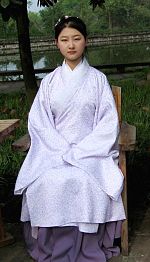Chang'ao
This articlepossibly containsoriginal research.(July 2016) |
| Chang'ao | |||||||
|---|---|---|---|---|---|---|---|
 Woman wearing a chang'ao. | |||||||
| Traditional Chinese | Trường áo | ||||||
| Simplified Chinese | Trường áo | ||||||
| Literal meaning | Long jacket | ||||||
| |||||||
Chang-ao(simplified Chinese:Trường áo;traditional Chinese:Trường áo), lit. translated as "long jacket" or "longao",[1][2]is a historical long-length, Chinese upper garment calledao( áo ), which was worn by women. It is also known asda ao( đại áo )[2]andchangru( trường nhu; longrujacket) which appears to be the precursor of theao.[3]
When paired with a skirt, thechang-aoforms a style ofaoqun(i.e. jacket worn over a skirt).[4]This set of attire is worn as a formal attire.
History[edit]
In theMing dynasty,the wearing of long-length upper jacket (ao) with skirts became more prevalent than the wearing of short upper jacket with skirts.[3]Several paintings, book illustrations, tomb artefacts, and references from books which dates from the lateMing dynastyshow that women were wearing long-lengthaowith a skirt during this period.[3]
The combination of long-lengthaowith skirt continued to exist in theQing dynasty.[3]However the style of Ming dynastyaocontinued to evolve under the influence of theManchufashion.[5]By the late Qing dynasty, it was typical for theaoto be waist-length.[5]The late Qingaoalso had different types of opening (i.e. central front opening, slant opening), could have either narrow or wide sleeves and could have amandarin collar.[5]
After the fall of the Qing dynasty, theaocontinued to be worn in theRepublic of China;the 1910saostyle was once again lengthen up to hip level, and sometimes up to the knees.[5]It was once again shortened in the 1920s to be waist-length.[5]
Construction and design[edit]
Thechang-aowas actually developed fromzhiduoduring theMing Dynasty,and is worn over a skirt. It is wide-sleeved, shorter than zhiduo and has no side panels ( ám bãi ) at the side slits (thus showing the skirt worn underneath). There is often an optional detachable protective huling ( hộ lĩnh, lit. "protect collar" ) sewn to the collar. The huling can be of white or any other dark colours. The collar is of the same colour as the clothing.
Gallery[edit]
-
Portrait of noblewomen wearing Chang-ao withmandarin square
-
Portrait of noblewomen wearing round-collared Chang-ao withmandarin square
Related clothing[edit]
See also[edit]
- Hanfu
- List of Hanfu
- Ru- Chinese upper garment
References[edit]
- ^"5 Steps to Figure Out the Chinese Female Outfits (Ming) - 2021".www.newhanfu.com.Retrieved2021-06-10.
- ^ab"Hanfu Making(2) - Aoqun Cutting & Sewing Patterns - 2021".www.newhanfu.com.Retrieved2021-06-10.
- ^abcdFinnane, Antonia (2008).Changing clothes in China: fashion, history, nation.New York: Columbia University Press. pp. 48–52.ISBN978-0-231-14350-9.OCLC84903948.
- ^Wang, Xinyi; Colbert, François; Legoux, Renaud (2020)."From Niche Interest to Fashion Trend: Hanfu Clothing as a Rising Industry in China".International Journal of Arts Management.23(1).Retrieved1 February2021.
- ^abcdeJiang, Wanyi; Li, Zhaoqing (2021-01-06).Analysis on Evolution, Design and Application of Women's Traditional Coats in Beijing in the Late Qing Dynasty and the Early Republic of China.Atlantis Press. pp. 641–648.doi:10.2991/assehr.k.210106.123.ISBN978-94-6239-314-1.


